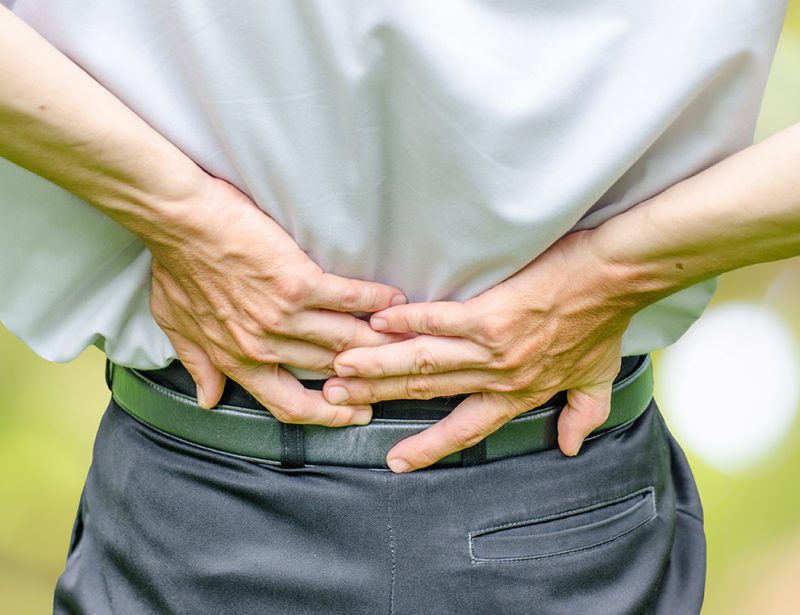During their lifetime, as many as eight out of 10 people experience back pain that lasts more than three days. However, for a vast majority of these people, the pain goes away with simple treatment.
Most lower back pain is acute, lasting fewer than six weeks. The most common causes are muscle or ligament strain and damage to the discs, which act as cushions between the bones in the spine. These injuries often occur following heavy lifting, extensive bending over or hours of sitting during a long airplane or car ride. The pain typically starts in the lower back and extends down either leg.
Anyone can develop back pain, but it is more common as we age. In adolescents, back pain is usually caused by stress fractures due to overuse, especially among athletes and dancers. Back pain experienced by adults through their 40s tends to be disc-related. Older adults are likely to suffer from stenosis, or narrowing of the spine. Other causes of back pain can include shingles, infections and osteoporosis.
The majority of back pain can be managed without surgery. In fact, studies have shown that patients who suffered disc herniation with pain traveling down the leg experienced similar long-term pain reduction regardless of surgical or nonsurgical treatment.
Treatment options
The first step toward relieving back pain is understanding it, according to Dr. Gregory G. Billy, a physical medicine and rehabilitation specialist with Penn State Sports Medicine who practices in State College, Pennsylvania.
“A physician should ask about the history of your pain, including its exact location, what makes it feel better or worse and what may have caused it,” Billy said. “A physical exam helps isolate the cause of the pain — for example, what happens when you stand, sit, lift your leg or walk?”
Although a magnetic resonance image – or MRI – can help confirm a working diagnosis, it’s important to remember that it’s only a picture, not a diagnosis or treatment.
“Because the back changes with age, MRIs of many older adults are likely to depict damage, but the damage captured in that image may not be the current cause of back pain,” Billy said.
For minor acute injuries, treatment can include the following:
- Over-the-counter pain relievers or nonsteroidal anti-inflammatory drugs (NSAIDs), such as ibuprofen, can be taken.
- Apply ice to stop spasms; apply heat to relieve soreness or aching.
- Individuals should maintain normal daily activities as much as possible, as long periods of bedrest lead to tightening of the muscles and spine.
When at-home measures don’t relieve back pain, a physician often considers three nonsurgical treatment options:
- Physical therapy, which can feature heat, ultrasound or transcutaneous electrical nerve stimulation (TENS), as well as physical exercises supervised by a professional therapist.
- Noninvasive prescription drugs, such as anti-inflammatories, muscle relaxers, oral steroids and topical pain relievers.
- Steroid injections into the epidural space around the spinal cord can provide months of pain relief.
Preventing back pain
Often, simple lifestyle changes can reduce the likelihood of suffering back pain in the future. They include the following:
- Exercises to strengthen the abdominal and back muscles that help support the torso. Through stretching or yoga, gain flexibility in the hips and upper legs.
- Increase endurance through low-impact aerobic activities, such as walking and swimming.
- Lose excess weight to relieve stress on the back. Lift heavy items by following these guidelines: keep back straight, bend at knees and use leg strength.
- When standing for long periods, alternate resting one foot and then the other on a low stool to relieve back stress.
- Choose seats or chairs with solid lower-back support and armrests.
- When sitting, take frequent breaks to stand or walk around. A recent Penn State study found that people who sat for four hours at work actually lost lumbar disc height during that time – compressing the cushions between the bones of the spine. However, those who changed positions and stretched every 15 minutes had no measurable loss.
“Being proactive may prevent back pain from recurring, or even developing in the first place,” Billy said.
Learn more:
- Join Dr. Billy for a live online chat from 1 to 2 p.m. Thursday, Nov. 17
- Contact Penn State Sports Medicine, a part of Penn State Medical Group in State College, at 814-865-3566.
The Medical Minute is a weekly health news feature produced by Penn State Health Milton S. Hershey Medical Center. Articles feature the expertise of faculty physicians and staff, and are designed to offer timely, relevant health information of interest to a broad audience.
